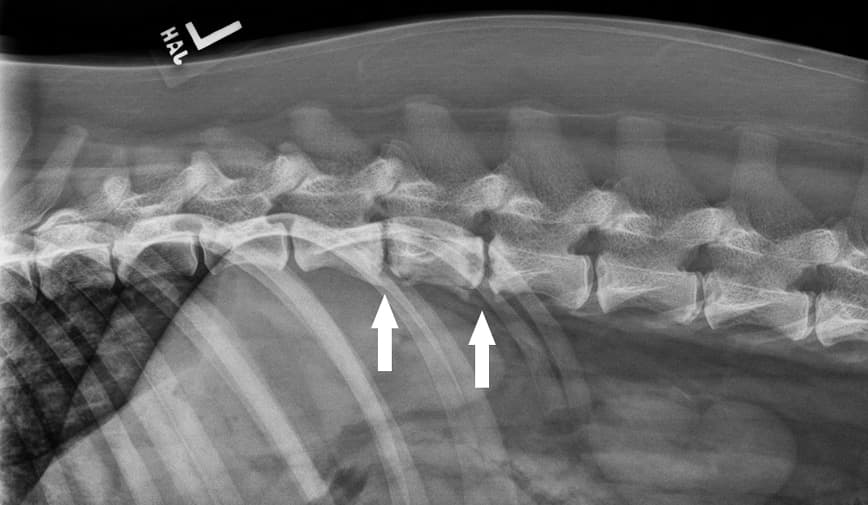Discospondylitis is a disease marked by inflammation within the spinal column, stemming from an infection that affects the intervertebral discs, the vertebrae adjacent to these discs, and the bone structure of the vertebrae themselves. This condition is primarily caused by a bacterial infection, which often spreads through the bloodstream from distant parts of the body like the urinary system, skin, or oral cavity. Although cases are predominantly seen in dogs, incidences in cats, horses, and even pigs have been documented. Research, including a significant study by Burkett et al., has highlighted a predisposition in male, older, and purebred dogs, with certain breeds such as Great Danes and Labrador Retrievers being more susceptible.
Symptoms and Diagnosis
Animals afflicted with discospondylitis exhibit a range of symptoms from spinal pain to more severe neurological impairments, such as difficulty walking or complete paralysis. These symptoms may fluctuate in intensity and often become more pronounced with physical activity. The disease is diagnosed primarily through radiographic imaging, which may show specific changes like the erosion of vertebral endplates. However, MRI and CT scans can detect the disease earlier and more accurately in many cases. Identifying the causative microorganism is crucial for guiding the treatment approach, which often involves detailed analysis through blood, urine, and sometimes disc material cultures.
Treatment and Management
The cornerstone of managing discospondylitis involves administering targeted antibiotics to eliminate the underlying infection. In situations where the infecting organism is not identified, which occurs in a significant portion of cases, empirical antibiotic treatment is initiated. For dogs exhibiting severe neurological deficits, surgical interventions may be necessary. Alongside medical treatment, restricting the animal’s physical activity is recommended to aid recovery. Follow-up care is critical to ensure the resolution of the infection, with regular imaging to monitor the disease’s progression and response to treatment.
Study Overview and Methodology
This article reviews a comprehensive study conducted over twelve years, aiming to document the clinical features and outcomes of discospondylitis in dogs across various geographical locations. The study included a review of medical records from multiple institutions, a detailed analysis of imaging findings, and assessment of treatment effectiveness and complications. Statistical analysis was used to identify breed predispositions and the impact of various risk factors on the prognosis.
Results and Discussion
The study revealed a broad range of clinical presentations and outcomes, with certain breeds showing a higher predisposition to the disease. Imaging studies underscored the importance of advanced modalities like MRI for early detection. The findings also highlighted the critical role of comprehensive microbial testing, including cultures for bacteria and fungi, to guide treatment. The study’s results contribute to a better understanding of discospondylitis’s clinical management and emphasize the need for early diagnosis and targeted treatment to improve outcomes.
Unique Insights into Discospondylitis
- Multifaceted Origins: Although the disease primarily originates from bacterial infections, its rare cases linked to migrating foreign bodies and trauma underline the complexity of its causes;
- Breed Specificity and Genetics: Certain breeds’ overrepresentation suggests a genetic predisposition, opening avenues for future genetic studies;
- Innovative Treatments on the Horizon: With ongoing research, the potential for novel therapies, including targeted immunotherapy and advanced antibiotic delivery methods, is vast.
Comparative Table: Discospondylitis Diagnosis Techniques
| Diagnostic Technique | Advantages | Disadvantages | Detection Rate |
|---|---|---|---|
| Radiography | Widely available, non-invasive | May not detect early disease | Moderate |
| MRI | High sensitivity, detailed imaging | Costly, not as widely available | High |
| CT Scan | Detailed bone structure imaging | Less effective for soft tissue | Moderate-High |
| Culture & Sensitivity | Direct identification of pathogen | Time-consuming, may not always yield results | Variable |
Advanced Treatment Approaches
In recent years, the approach to managing discospondylitis has evolved beyond traditional antibiotic therapy. The introduction of precision medicine, particularly in the realm of genomics, holds promise for developing personalized treatment plans based on the genetic makeup of individual patients. This advancement could lead to more effective treatments with fewer side effects. Furthermore, the use of bacteriophages as a treatment modality presents an innovative method to target resistant bacterial strains.
These viruses specifically infect and lyse bacteria, offering a potential solution to the growing issue of antibiotic resistance. Additionally, stem cell therapy has emerged as a regenerative treatment option, aiming to repair damaged spinal tissues and potentially reverse the effects of discospondylitis. As research progresses, these advanced treatments could significantly improve outcomes for affected animals.
The Impact of Early Diagnosis
Early diagnosis of discospondylitis is paramount to successful treatment outcomes. With the advent of sophisticated imaging techniques such as MRI, veterinarians can detect the disease at its nascent stage, significantly improving the prognosis. Early intervention allows for the immediate commencement of targeted therapy, reducing the likelihood of the infection spreading or causing irreversible damage to the spinal structure. It also minimizes the risk of severe neurological deficits that can drastically affect the quality of life of the animals.
Educating pet owners on recognizing early signs of spinal discomfort and seeking prompt veterinary care is crucial in the battle against discospondylitis.
Long-term Management and Prognosis
The journey to recovery from discospondylitis involves more than just overcoming the initial infection. Long-term management strategies, including physical rehabilitation and ongoing monitoring, are essential to ensure a full recovery and prevent relapses. Rehabilitation exercises improve strength and flexibility, helping animals regain mobility and reduce the risk of future spinal issues. Regular follow-up visits and imaging allow veterinarians to monitor the healing process and adjust treatment plans as needed.
While the prognosis for bacterial discospondylitis is generally favorable with early and appropriate treatment, cases involving fungal infections or significant neurological damage require more intensive management and may have a more guarded outlook. Owners’ commitment to long-term care plays a crucial role in their pets’ recovery and overall well-being.
Conclusion
In wrapping up our exploration of discospondylitis, we’ve traversed through its definition, origins, symptomatic presentations, and advanced strides in diagnosis and treatment. This condition, rooted in infection and inflammation of the spinal components, not only underlines the critical need for early detection and intervention but also highlights the evolving landscape of veterinary medicine in combating such ailments. Our journey underscored the pivotal role of innovative imaging techniques and the potential of personalized medicine in revolutionizing treatment approaches.
Moreover, the discussion illuminated the significance of understanding breed predispositions and genetic factors, offering a beacon for future research aimed at prevention and better management strategies. As we advance, the synergy between cutting-edge technology and comprehensive microbial analysis stands as a testament to the progressive strides being made in ensuring the health and well-being of our canine companions and other susceptible species.
Embracing these advancements, coupled with a commitment to long-term care and rehabilitation, paints a hopeful picture for managing discospondylitis. It not only enhances the quality of life for affected animals but also enriches our understanding, enabling us to step confidently towards a future where this condition can be addressed with greater precision and empathy.



